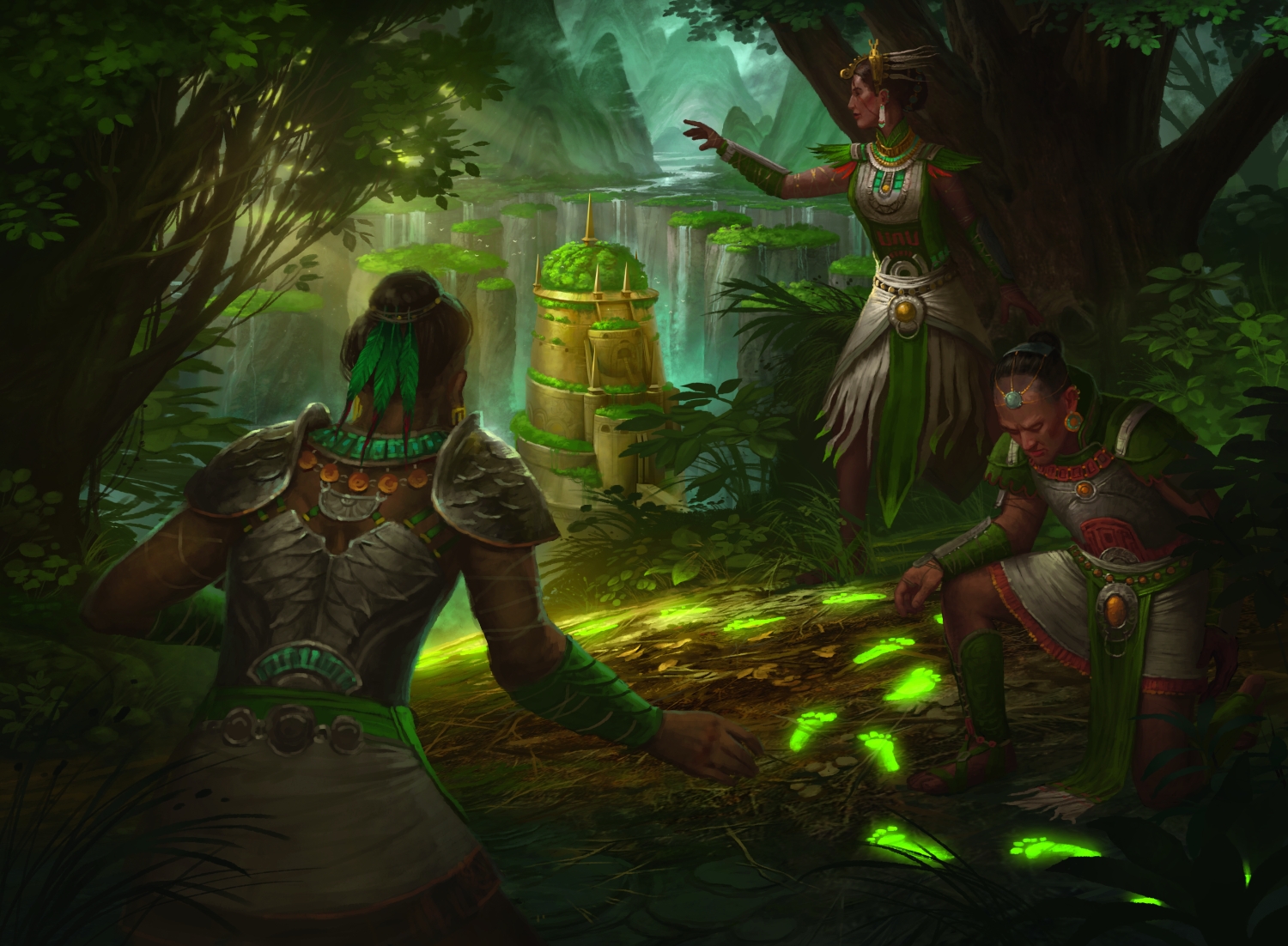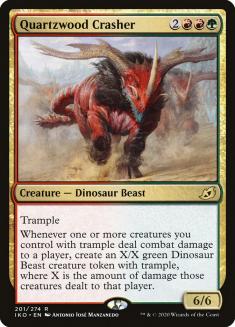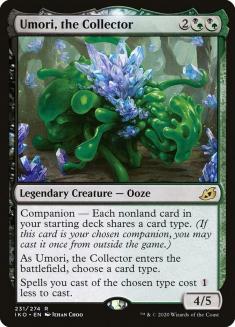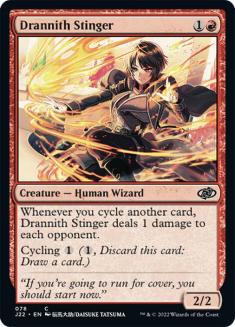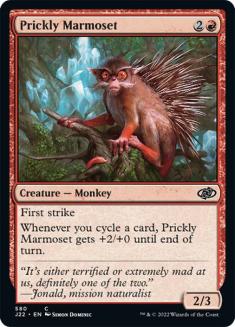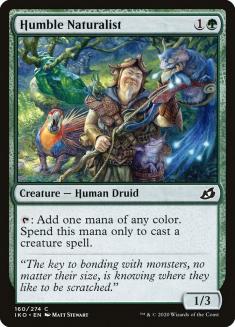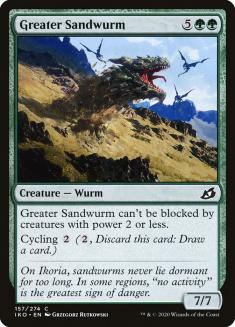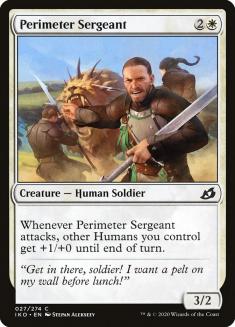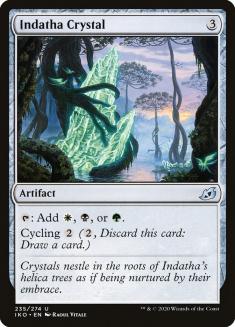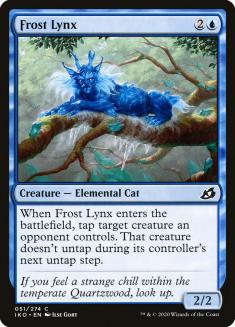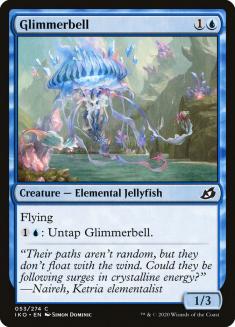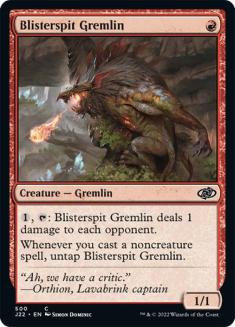There is a lot going on in this decision. Let’s break this down in terms of potential paths-to-archetypes in order of priority:
1. Green-base Umori
2. Boros or Rakdos Cycling
3. Rakdos or Golgari Reanimator
Note: There are many other potential decks that are less potent than the ones described above. We can eliminate considering these paths from this decision as it’s very unlikely that none of the above strategies are sufficiently available to draft given the current pool of cards.
The ranking of these paths is due to a combination of deck strength and likelihood of getting all the necessary cards. For example, if or were already in the pool, then the Reanimator strategy would be ranked ahead of the cycling strategy. And Umori is the top strategy because, well, companions are busted.
about the current pool of cards for just one moment. about what you think is the correct pick from the pack given the pool of cards. Look at just the pack and the potential archetypal options. Imagine what your final deck for those options looks like. Picture different versions of the archetypes. Does any card in this pack fit better in the decks you just imagined than the rest of the options? Did your answer change from when you were considering the full pool of cards?
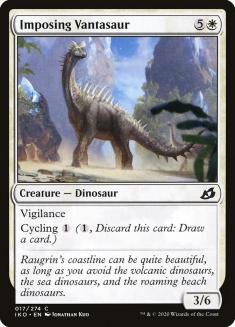
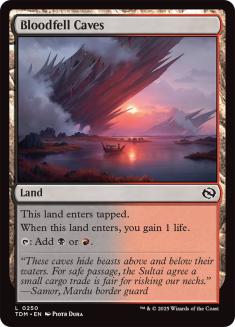
I am considering , , , and . This is because I believe all of these options could make at least four out of the five potential archetypes. But which fits the mold the best?
makes 100% of decks. The Umori deck has and such that casting the Vantasaur is feasible. And any large creature with cycling is going to be solid in the Reanimator deck. However, the card doesn’t actually contribute meaningfully to either strategy. It’s a fine card that will see play, but outside of the cycling decks, it’s nothing special.
is quite similar to Vantasaur. Umori decks love to splash, and it’s especially helpful with . Boros will play the land to help cast . But again, the card makes minimal contribution to what these decks look like at the end of the draft.
The pick boils down to and . Both cards are castable in most potential archetypes. , when considering the pool, looks enticing. I’m likely to be an Umori deck, and without access to classic removal spells, doesn’t become premium? It certainly becomes better, but I wouldn’t argue “premium.” Generally, Umori decks prefer to . The most common logic I hear pushing towards over Whisperer has to do with the current pool: “The pool lacks mutate enablers and payoffs, hence doesn’t make much sense.”
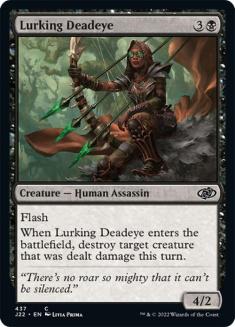
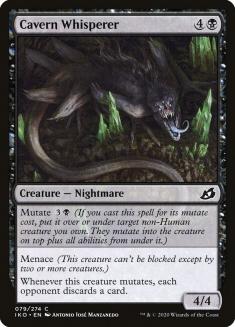
This is a fallacy. Currently, my pool contains seven cards. My final pool will contain 45. This means that the current pool only makes up fifteen percent of my final pool. There are mutate payoffs and mutate enablers in abundance. With 38 picks left in the draft, there is a high probability that I have the opportunity to draft multiple of both mutate enablers and payoffs. Add in the understanding that the best Umori decks are built as green-base multicolor mutate decks, and becomes the clear pick.
This doesn’t mean that it is objectively incorrect to take . If you believe that Umori decks look differently, and don’t hedge on mutate synergy, I can get behind the pick. However, if you would take if the current pool contained and , then the lack of those cards should not deter you from taking this early in the draft.
If this was later in the draft, the probability of picking up those cards would lower such that becomes a less potent pick. This implies that, at different stages in a draft, it is necessary to consider information in different ways. This is because the relevance of information with respect to the target – ending up with a strong deck – changes over time. The tradeoff between information representation over time can be described with one of the most important principles in Information Theory.
The Information Bottleneck
Note: I will not delve into the math related to the Information Bottleneck. If you would like to take the time to learn more about it, check out the original paper.
It is impossible for any individual, at a given point in a draft, to have perfect memory of previously observed information and perfect consideration for all future potential paths. Hence, a good drafter has some complex and abstract understanding of that information. It’s compressed. The Information Bottleneck provides a mathematical foundation for describing the tradeoff from how much to compress this information, and how that compression affects the target. The target, in this case, is a strong draft deck.
The “bottleneck” refers to the mechanism for compressing previous information. For Magic Draft, the “bottleneck” is the strategy for retaining and recalling information from an incomplete representation of previous packs. For example, I might remember that Pack 1, Pick 1 contained three one-mana cyclers rather than memorize the exact contents of the pack. And I am incentivized to remember packs this way, because it helps me navigate a draft towards the best archetype: cycling. The optimal form of information compression will always be with respect to paths, and hence decks.
Information compression, and recall from that compression, is a skill.
A common Limited heuristic is “signals you read matter much more than the signals you send.” The reason this heuristic exists is because it informs how to pay attention to signals, and which signals to incorporate into our compressed representation of information. Furthermore, it’s unnecessary to waste mental bandwidth on perfect recall of pack contents. Consider the situation in Pack 1, Pick 2 with three blue cards, four red cards, three black cards, one white card, and three green cards. Instead of remembering that entire pattern, it’s best to remember “Pack 1, Pick 2 contained only one white card.” This way, if that white card wheels, it is easy to recall that zero white cards were taken out of that pack.
Furthermore, If zero red cards wheel, given the mental note of the color white and not red, it is reasonable to conclude that multiple red cards have been taken out of the pack. This is a prime example of how information compression, and recall from that compression, is a skill. I was able to devise a very simple description of a complex pack that still provided expression of that complexity. However, the bottleneck I used to compress the information can’t work for every individual.
Every individual is different. I agree with Sam Black that “different picks are right for different people.” Often this has to do with archetypal bias. But this can also have to do with energy expenditure. Consider a drafter with a very poor working memory. It would require a significant amount of effort for that person to properly remember the contents of packs. Spending that energy likely comes at the consequence of retaining other important information. Hence, the tradeoff for incorporating that information into their decision process can have a negative effect on their draft.
The lesson behind the Information Bottleneck is that there exists an optimal bottleneck, and it is not objectively “remember the most information possible.” This requires assessment on a personal level. Choosing what information is best to incorporate in decisions is a skill, and is a function of each individual person’s efficacy to retain, compress, and recall that information. The rest of this article describes a framework for thinking about Drafts in terms of stages with respect to paths. This is the framework I use to devise my bottleneck, as it greatly simplifies the amount of effort required to compress information.
Strategies Over Time: States
Draft can be broken up into six fundamental stages:
1. The Initial Stage (Pack 1, Pick 1 through Pack 1, Pick 3)
The general consensus among veteran drafters is that, during this stage, it is optimal to just take the best card out of the pack. The reason for this is that it maximizes the potential number of paths the draft can go on, which is equivalent to “staying open.” In the first couple of picks of a draft, the number of future picks outweighs the size of the current pool by such a large amount that it is often correct to ignore the cards drafted so far.
2. The Hedging Stage (Pack 1, Pick 4 through Pack 1, Pick 8)
At this stage, all paths are still available, but their likelihoods begin to focus. If I draft four red cards in a row, I can still end up drafting Azorius, but I am much more likely to draft any of the red archetypes. The strategy at this stage is to lean into those probabilities. A red card becomes much more valuable than a card of any other color because it belongs to the set of paths with a higher likelihood of yielding the best deck. However, relatively strong and/or splashable cards can incentivize deviating towards strategies not conducive to the current pool. It’s still early enough to pivot.
3. The First Wheel (Pack 1, Pick 9 through Pack 1, Pick 15)
This is arguably the most important part of any draft. It is the first instance of clear signals, as you can be 100% certain what cards are missing from the packs if you’re able to recall that. Based on this information, the probability of going down any path changes, sometimes so strongly that it is a more impactful factor than the current draft pool. This probabilistic update ripples through the entire draft process.
This introduces a crucial observation: every stage is fed information from every preceding stage, and affects every succeeding stage. The real question is not “What information do I need to consider in Stage X in order to make the best picks during Stage X?” but rather “What information do I need to gather/compress during Stage X in order to recall it later and inform decisions in Stage Y?”
The First Wheel converts the compressed information of “Pack 1, Pick 2 contained one white card” to “There is a reasonable probability that at most one person at the table is drafting white.” It is no longer necessary to retain the specifics of Pack 1, as the generalized information from the wheel is what gets propagated to inform Pack 2 and Pack 3.
This is the Information Bottleneck at work. Devising the proper narrative of information at this stage is crucial to successfully navigating the rest of the draft. The biggest piece of advice I can provide is to pause at the end of each stage and attempt to summarize the information of the draft so far. This dialogue creates that abstract representation of previous packs, improving information recall for future decisions.
4. The Solidification Stage (Pack 2, Pick 1 through Pack 2, Pick 8)
With a reasonable understanding of what’s open at the table and a solidly sized draft pool, by the end of this stage the number of potential paths converges to one. Pivoting into a different archetype after this stage is an extremely rare occurrence, and hence the strategic goal of this stage is to select an archetype from the potential paths available.
I also like to call this “the Forgetting Stage” because, at the end of the stage, you can forget a lot of information. Once I solidify into a Rakdos archetype, it is no longer necessary to remember anything about any nonred and nonblack color in Pack 1. Seeing five copies of in Pack 1 becomes a more relevant observation than wheeling zero blue or green cards. It no longer matters what other colors are open. But understanding that all the black decks likely have at least one means I can try to wheel the card in Pack 3.
5. The Second Wheel (Pack 2, Pick 9 through Pack 2, Pick 15)
The Second Wheel has a surprisingly different purpose from the First Wheel. The First Wheel is all about assessing the macro-behaviors of the table in order to update the probability distribution describing the potential paths you can take. During the second wheel, you should already know what path you are on. Draft decisions often boil down to “the best card for my archetype,” which doesn’t require strategic complexity outside of understanding when to deviate, for example, by taking a two-drop for curve considerations.
For information compression, this stage is about aligning wheeling patterns for the expectation of what might wheel in Pack 3. Let’s say I’m drafting Simic and wheeled in both Pack 1 and Pack 2. I believe that is close to a premium removal spell, but it is pretty clear that the table I am at disagrees with this. If I remember that in Pack 3, I can pass a that I would usually take, because there is a reasonable probability that the card wheels.
6. The Final Stage (Pack 3, Pick 1 through Pack 3, Pick 15)
The Final Stage is about filling in the gaps. the exercise at the beginning of this article, where you imagined a future Umori deck. At the Final Stage, the draft pool contains enough cards that the difference between the current deck, and the imagined deck, is small. Navigating this stage requires the least amount of previous information from the rest of the draft, but rather relies on clear vision of what the best version of the deck can look like and prioritizing the cards that turn the current pool into that deck.
The sequences of these stages define the structure of Draft navigation. Furthermore, this structure enables thinking about drafts in terms of path convergence. At the Initial Stage, all paths are options. By the Final Stage, one path has been chosen. This leads down a very interesting road of discerning patterns between different paths. If two different paths often track together through stages, they become easy to pivot between. Knowing this before the draft starts opens the door for even more Draft navigation tactics!
Learning Paths Before the Draft
In order to properly inform Draft navigation decisions, it is necessary to have the following understandings before the draft starts:
1. What good decks of each potential archetype look like
2. How paths of different archetypes overlap
The first note is something that you are likely familiar with. Reading my content and seeking out trophy decks via Twitter, Discord, and messages with friends is a very common way to become intimately familiar with the architecture of archetypes. As described in the sections above, the image of a strong final deck for an archetype has a large influence on what the correct pick is out of any pack. However, there is another layer to these decisions. In Pack 1, it is common to navigate a draft towards multiple potential paths. And there are certain rules that govern the best way to toe the line between those paths.
First and foremost, overlapping paths have a high correlation between overlapping colors. Paths are sequences of picks, hence it is very unlikely that a path for Gruul comes from the same decision tree as a path for Dimir. However, it is fairly common for a draft to start in one color and hedge between a few potential paths. Many players understand this improvisationally. They can observe that they are certainly blue, and hence seek out all the blue archetypes. But the patterns relating these paths are often choreographed.
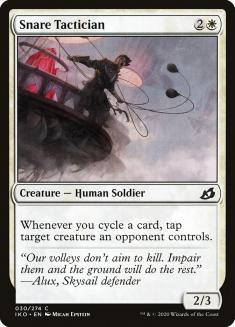
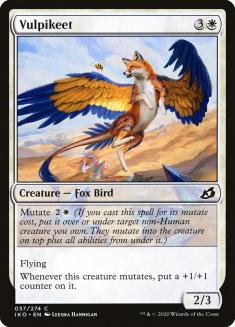
Consider Azorius in Ikoria Limited. Unintuitively, the most common path for Azorius starts with red cards. Izzet and Boros lend themselves well to decks with cycling synergies, and hence it is correct to lean towards red with a cycling start. But what happens when red isn’t open? Azorius is actually the easiest backdoor. is the most impactful common that can still make use of the cycling prioritization from the given start. Furthermore, by the time it is apparent that red is so closed that a pivot is necessary, the draft pool likely contains multiple white and blue cards.
Azorius is not as much a cycling deck as it is a midrange deck that can utilize cycling synergies. But understanding, before the draft starts, that Azorius paths are intertwined with red cards and cycling starts is crucial for navigating drafts properly. For example, if I am drafting Boros, in Pack 3 I will never prioritize . However, is a very strong common in most Azorius decks, and given that the early Azorius path is closely intertwined with the early Boros path, taking in the Hedging Stage and the First Wheel keeps that option open.
Draft decisions are so much more than considering the current pool with respect to the options available in the current pack. Optimal navigation strategy requires not only an understanding of individual cards and archetypes but also information compression of observed packs so far and an intimate familiarity with how different paths to archetypes overlap during the navigation process. While it’s a lot of information to consider, improving your ability to take all of this into account will certainly take your game to the next level!

